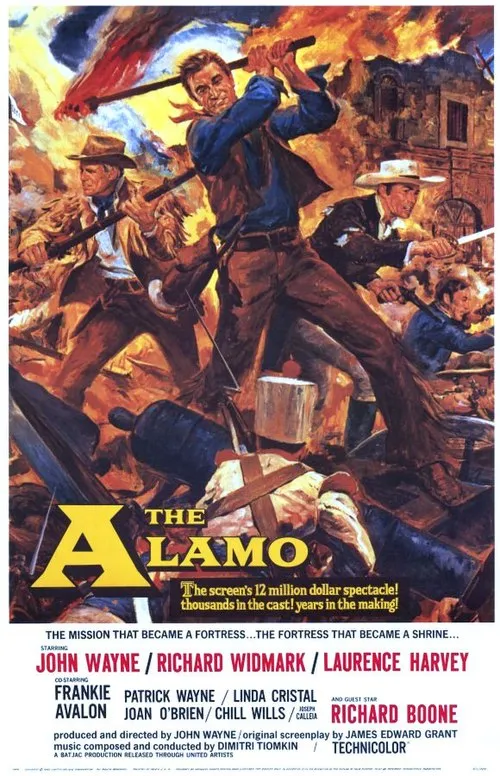Historical accuracy of The Alamo

Historical accuracy of The Alamo

Characters
Colonel Davy Crockett
Crockett was at the Alamo. However, John Wayne's portrayal reflects the popular legend and Wayne's own persona more than the historical Crockett, who was a politician trying to revive his career.
Colonel Jim Bowie
Bowie was a real co-commander of the volunteers, famous for his knife. The film captures his larger-than-life reputation and illness during the siege, but specific interactions are dramatized.
Colonel William B. Travis
Travis was the commander of the regular troops. The film depicts his leadership role and determination ("Victory or Death" letter context) but simplifies his personality and conflict with Bowie.
General Antonio López de Santa Anna
Santa Anna led the Mexican army and ordered the assault. His portrayal as a ruthless antagonist is based on his historical role, though characterized negatively to fit the film's narrative.
General Sam Houston
Houston was the commander-in-chief. His strategic decision not to relieve the Alamo is historically accurate, though his direct influence as shown in the film might be limited.
Smitty / Beekeeper / Tennessean
Represents the volunteers who came with Crockett but is a fictional character, likely composite, serving as an audience viewpoint character.
More characters
Captain Almaron Dickinson
Dickinson was a real officer commanding the artillery at the Alamo.
Susanna Dickinson
Susanna Dickinson was one of the few non-combatant survivors, whose testimony provided accounts of the battle's final stages.
James "J.B." Bonham
Bonham was a real messenger who famously returned through enemy lines to the Alamo, knowing the situation was hopeless.
Flaca (Pilar)
A fictional character created entirely for a romantic subplot for John Wayne's Crockett, with no basis in historical accounts.
Blind Nell (Nell Pauley)
A fictional character representing local civilians or adding color, not based on a specific historical person.
Parson
Likely a fictional composite representing the religious sentiments among some defenders.
Story
Context: Texas Revolution for Independence
The battle occurred during the Texas Revolution where Texan settlers sought independence from Mexico.
Crockett arrives with Tennesseans
Davy Crockett did arrive at the Alamo with a small group of volunteers from Tennessee shortly before the siege began.
Travis/Bowie command conflict
There were tensions and a complex joint command structure between Travis (regulars) and Bowie (volunteers) initially, though Bowie's illness later simplified command under Travis.
Travis draws line in the sand
This iconic moment where Travis draws a line and asks defenders to cross if they'll stay is a legend, first appearing decades later, with no contemporary evidence it happened.
Santa Anna arrives / Siege begins
Santa Anna's army arrived in late February 1836, initiating the 13-day siege of the Alamo.
Calls for reinforcements / Bonham's return
Travis sent out several letters pleading for reinforcements, and messengers like Bonham did carry these pleas, with Bonham returning despite the danger.
Life during the 13-day siege
The film depicts skirmishes, bombardment, and daily life. While details are dramatized, the basic situation of being besieged for 13 days is accurate.
Fictional subplots (Crockett/Flaca, Smitty's journey)
Romantic subplots involving Crockett and Flaca, or personal stories of fictional characters like Smitty, are entirely fabricated for the film.
Bowie's illness on his cot
Jim Bowie became seriously ill (likely typhoid pneumonia or tuberculosis) early in the siege and was confined to his cot during the final battle.
Final pre-dawn assault (March 6, 1836)
Santa Anna launched a large-scale assault on the Alamo before dawn on March 6, 1836.
Mexican army overwhelms defenses
Despite fierce resistance, the vastly outnumbered defenders were eventually overwhelmed as Mexican troops breached the walls from multiple directions.
Heroic deaths of Travis, Bowie, Crockett
All three died (True). Travis died early defending the north wall (Partly True). Bowie died in his bed (Partly True). Crockett's death fighting and blowing up the magazine is fictional (False).
Death of nearly all male defenders
All or almost all of the combatants inside the Alamo were killed during or immediately after the battle.
Survival of women, children (Susanna Dickinson)
A small number of non-combatants, mostly women, children, and some slaves (like Travis's slave Joe), were spared by Santa Anna.
Crockett's manner of death (fighting vs. execution)
The film depicts Crockett dying fighting. Some historical accounts (e.g., de la Peña diary, authenticity debated) suggest Crockett was captured and executed, contrasting sharply with the film's heroic demise.
Setting
The Alamo mission compound set
The large replica built for the film (Alamo Village) was significantly larger, cleaner, and more fortress-like than the actual, partly ruined Alamo mission compound of 1836.
San Antonio de Béxar / Texas surroundings
Filmed in Texas, the movie captures the general look of the South Texas landscape, providing an authentic environmental backdrop.
1830s Texas period setting
The film generally succeeds in evoking the atmosphere of frontier Texas in the 1830s through props, costumes, and tone.
Costumes (Texan frontiersmen, Mexican soldiers)
Costumes for the defenders (buckskins, settler clothes, few uniforms) and the Mexican army appear appropriate and visually distinct for the period, based on conventions of the time.
Weaponry (Flintlocks, cannons, knives)
The film features flintlock rifles (like Crockett's "Old Betsy"), muskets, cannons, and Bowie knives used by Texans, and Baker rifles/muskets/lances for the Mexican army, typical of the era.
Depiction of siege tactics / Final assault
Shows bombardment and mass infantry assault. While visually impressive for 1960, the tactics are simplified and focus on heroic individual actions rather than coordinated military maneuvers.
Living conditions during siege
Suggests hardship but perhaps underplays the likely poor sanitation, limited supplies, and constant strain experienced during the actual 13-day siege.
Representation of Mexican Army
While uniforms look appropriate, the Mexican soldiers are often portrayed as a faceless horde, lacking individuality and reflecting negative stereotypes common in Westerns of the era.
Lack of Tejano representation among defenders
The film largely ignores the significant presence and role of Tejanos (Texans of Mexican descent) like Juan Seguin who fought alongside Anglo Texans for independence, including some at the Alamo.
